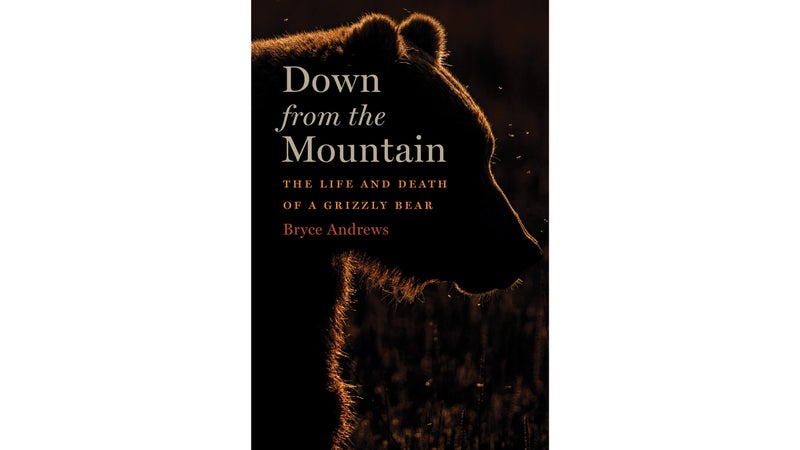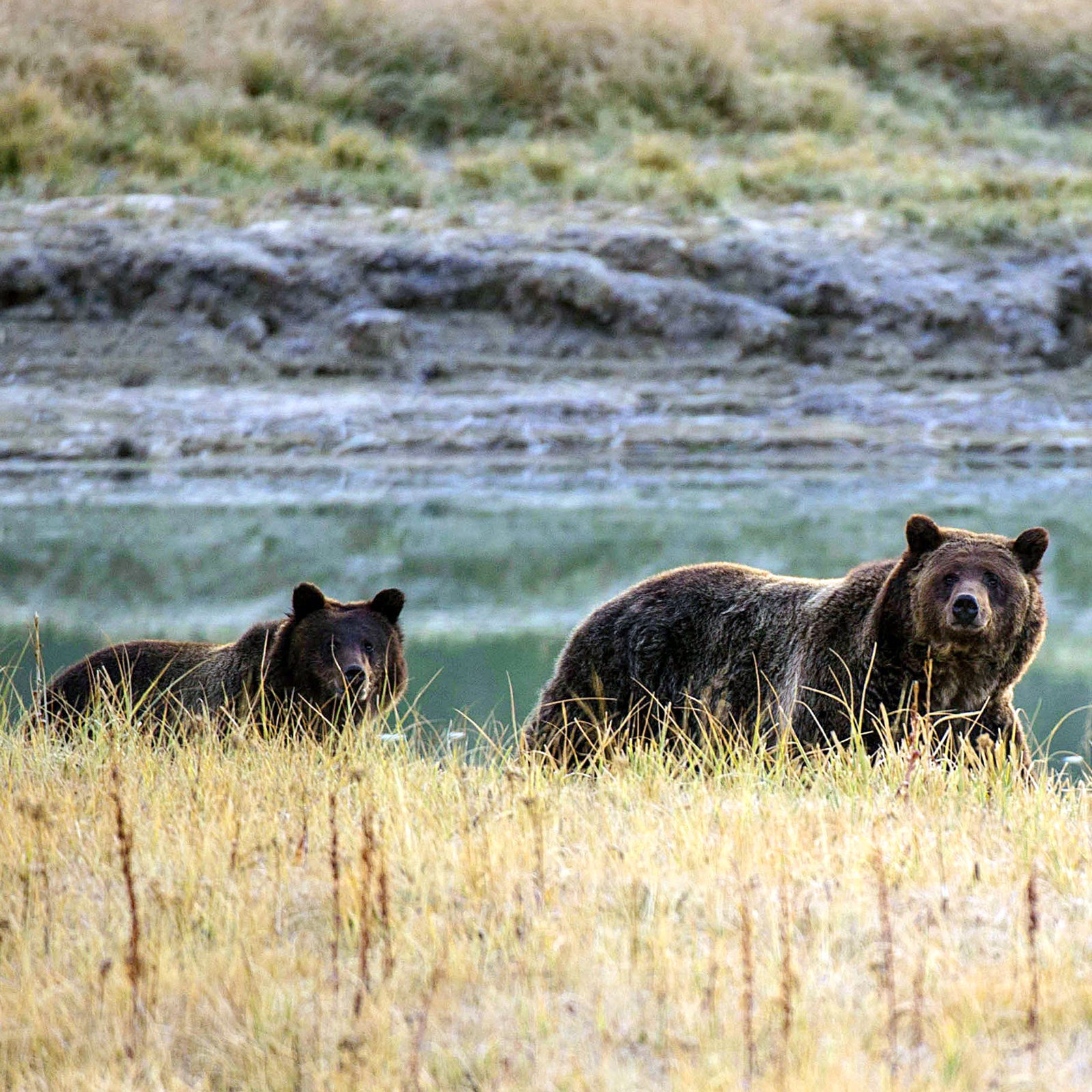In his 2013 book Feral, British author George Monbiot laments the fact that he feels ecologically bored: the UK has no apex predators on the landscape of which he should be afraid. Those of us who live in the American West, however, have enough wolves, cougars, black bears, and grizzlies roaming around to keep us on our toes. Often the less ecologically boring a place is, the bigger a conservation issue human-predator conflict becomes.
Bryce Andrew’s book Down from the Mountain ($25, Houghton Mifflin Harcourt) explores the issue in one particularly grizzly-dense location, Mission Valley, near Missoula, Montana. The book starts with the birth of a grizzly cub in the Mission Range, using information from bears that have been tagged and collared with GPS so that their movements can be tracked. Relying on scientific studies, the author describes the cub’s initiation into grizzly life by her mother before heading out on her own at age two. In 2006, she is caught by local conservationists, collared with GPS, nicknamed Millie after the woods in which she was trapped, and sent on her way.
The book then shifts to a parallel story, introducing Andrews, who used to be a Missoula-area rancher but, in 2013, realized that he wasn’t suited for the hard part of ranching: taking his cows to be butchered. “The essential gearing of my soul had been worn out by the task of turning animals into meat,” Andrews writes. He sells his ranch share to his partner and looks for other animal-related work that will keep his hands busy and his heart happy. He finds that connection with the nonprofit People and Carnivores, a Missoula group that works to mitigate relationships between the two.
It’s about the tightrope bears walk between living in their mountainous territory, consuming pine nuts, army cutworm moths, and winterkill, versus coming down the mountain to scavenge in human territory.
Andrews’s writing about wilderness is much like that of author Rick Bass, who displays both a healthy reverence for ecology and an easy way of talking about it. This story is not just about Andrews’s shift from rancher to conservationist. It’s an ode to wildness and wilderness in the form of grizzlies. It’s about the tightrope bears walk between living in their mountainous territory, consuming pine nuts, army cutworm moths, and winterkill, versus coming down the mountain to scavenge in human territory. It’s about the resulting relationship between humans and grizzlies when they live in close proximity.
On behalf of People and Carnivores, Andrews visits the Flathead Reservation to collaborate with its conservation team. The area has a large grizzly population and plenty of attendant human-bear interactions. Those problems are increasing annually: the bears eat livestock and dig up alfalfa fields to get gophers, and they’ve been eating cultivated tree fruit like apples for over a century, leaving wild fruit trees across the landscape. But that’s because people are making food too accessible by not using electric fencing and leaving fruit on trees for the bears to find. Once grizzlies are habituated to finding food in rural and suburban areas, they keep returning instead of going back up into the mountains.
Humans and grizzlies need to find a way to coexist because, as Andrews notes, “there are two kinds of mountains in Montana: those that still contain grizzlies and those that have lost them.” If there are too many nuisance bears in the Mission Valley, this could become a mountain region that loses its grizzlies.

The team decides to prioritize an affordable bearproof fence around farmer Greg Schock’s corn field, as he’s lost up to $10,000 from bears eating his corn, which is meant to be winter silage for his dairy cows. Corn is like junk food for bears—sugary, but without much substance. It’s a tricky conservation balance. The field shouldn’t have been planted in the first place since it’s so close to bear country, but Andrews understands that Schock is just trying to get by with his struggling dairy farm.
Meanwhile, Millie is teaching her two female cubs where to feed, how to travel quietly, and how to stay away from humans. Andrews weaves Millie’s story in alongside his own. He uses her abundant GPS-collar data to visit the potential denning sites she’s checked out and to write about food-gathering forays as if we’re right there with her and her cubs. It’s a pastoral section of the book, as Andrews builds his fence and Millie feeds and trains her cubs.
As he works, Andrews starts to feel the irresistible urge to see one of these fearsome predators up close, to ditch his “ecological boredom.” He has seen grizzlies previously during his ranching career and writes that “Looking bears in the face has given me a better grasp of what I am and how I fit into the old wilder world.” He tempts fate by walking into the cornfield where there could be a grizzly anywhere, noting somewhat romantically that “when a human meets a bear, their eyes meet like the two halves of a split stone.”
Andrews doesn’t encounter the grizzly he’d hoped to see: sleek, well-fed, large and lumbering. Instead, his and Millie’s stories collide when he discovers her on one of his trailcams—emaciated and with extensive facial damage after someone fired a load of buckshot at her. At this point, the book shifts briefly into a whodunit as the tribal game warden works with the U.S. Fish and Wildlife Service to find out who shot Millie (it’s illegal to shoot a grizzly). Her cubs, meanwhile, are sent to a zoo in Maryland.
Humans and grizzlies need to find a way to coexist because, as Andrews notes, “there are two kinds of mountains in Montana: those that still contain grizzlies and those that have lost them.”
Ultimately, Down from the Mountain addresses the difficulty of deciding which conservation projects are most important in areas where humans and apex predators exist and how we need to make (and save) room on the landscape for them to safely roam. It may not be easy, but it’s something we’ll have to think about more as the population grows and the linkages between humans and grizzlies become more entangled.
The outcome of the search and the completion of the electric fence don’t bring easy answers. Andrews still wonders: How can we maintain a healthy grizzly population so close to humans? How can humans and grizzlies coexist without bears becoming habituated to human food—especially when their traditional foods, like pine nuts, are declining due to human-caused climate change? And what does it mean for us environmentally and as a society to have apex predators wandering through our yards?


